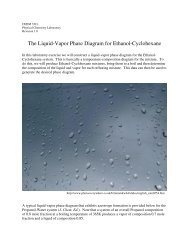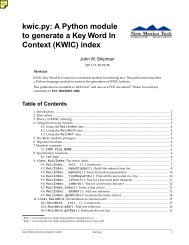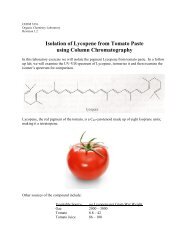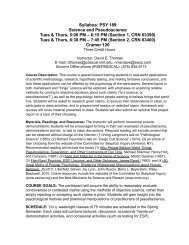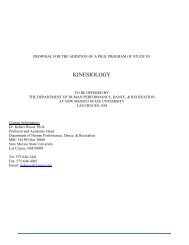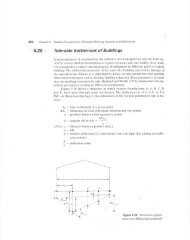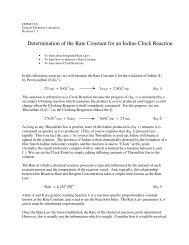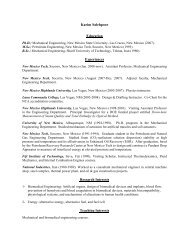is numerically equivalent to [0,1].
is numerically equivalent to [0,1].
is numerically equivalent to [0,1].
You also want an ePaper? Increase the reach of your titles
YUMPU automatically turns print PDFs into web optimized ePapers that Google loves.
Timothy Miles<br />
Math 352-01<br />
Section 6.2<br />
1, 12<br />
1<br />
a) Prove that every closed interval [a, b] <strong>is</strong> <strong>numerically</strong> <strong>equivalent</strong> <strong>to</strong> [0, 1].<br />
Numerical equivalence requires a bijection:<br />
Define f : R → R<br />
Given a < b, f(a) = 0, f(b) = 1 a linear formula with slope = (1 − 0)/(b − a)<br />
f(a) = 1 = a 1<br />
−a<br />
+ y-intercept = a/(b − a)+ y-intercept ⇒ y-intercept =<br />
b−a b−a<br />
f : f(x) = x 1 − a<br />
b−a b−a<br />
Surjective: Let set A represent the interval [a, b] and B represent the interval [0, 1]<br />
If x = a, f(a) = 0 ∈ B and f(b) = 1 ∈ B<br />
Since th<strong>is</strong> <strong>is</strong> a linear formula with slope 1 and (b − a) > 0 slope <strong>is</strong> positive and constant.<br />
b−a<br />
Therefore by Intermediate value theorem ∀x ∈ A, f(x) ∈ B<br />
Injective: Let f(x) = f(y) Show x = y<br />
f(x) = x 1 − a<br />
1<br />
and f(y) = y − a ⇒<br />
b−a b−a b−a b−a<br />
x 1 − a = y 1 − a ⇒ x 1 = y 1 ⇒ x = y ∴<br />
b−a b−a b−a b−a b−a b−a<br />
b) Prove that any two closed intervals [a, b] and [c, d] are <strong>numerically</strong> <strong>equivalent</strong>.<br />
As ealier, need <strong>to</strong> define a linear formula s.t.<br />
f : R → R<br />
Given a < b, f(a) = c, f(b) = d with slope d−c<br />
b−a<br />
Then f(x) = x d−c<br />
and y-intercept = c − a<br />
d−c<br />
b−a<br />
d−c<br />
+ (c − a )<br />
b−a b−a<br />
Surjective: Let set A represent the interval [a, b] and B represent the interval [c, d]<br />
If x = a, f(a) = c ∈ B and f(b) = d ∈ B<br />
Since th<strong>is</strong> <strong>is</strong> a linear formula with slope d−c and (b − a) > 0, (d − c) > 0 slope <strong>is</strong> positive<br />
b−a<br />
and constant. Therefore by Intermediate value theorem ∀x ∈ A, f(x) ∈ B<br />
Injective: Let f(x) = f(y) Show x = y<br />
x d−c<br />
d−c<br />
+ (c − a ) = y d−c<br />
d−c<br />
+ (c − a ) ⇒ x d−c = y d−c ⇒ x(d − c) = y(d − c) ⇒ x = y ∴<br />
b−a b−a b−a b−a b−a b−a<br />
12 Let A, B be sets contained in a universal set U such that A ⊆ B. Suppose that A <strong>is</strong><br />
countable and B <strong>is</strong> uncountable. Prove that B − A <strong>is</strong> uncountable.<br />
Proof by contradiction: Let B − A be countable<br />
Then B ∩ A ⊆ B by Theorem 2.2.1 Part 6<br />
Also the subset of a countable set <strong>is</strong> also countable<br />
1
We assumed B − A <strong>to</strong> be countable however, B − A <strong>is</strong> only countable when B <strong>is</strong> countable,<br />
but we were given that it wasn’t<br />
Therefore given A ⊆ B ∩ A, A countable and B uncountable B − A <strong>is</strong> uncountable<br />
2


![is numerically equivalent to [0,1].](https://img.yumpu.com/21969136/1/500x640/is-numerically-equivalent-to-01.jpg)
